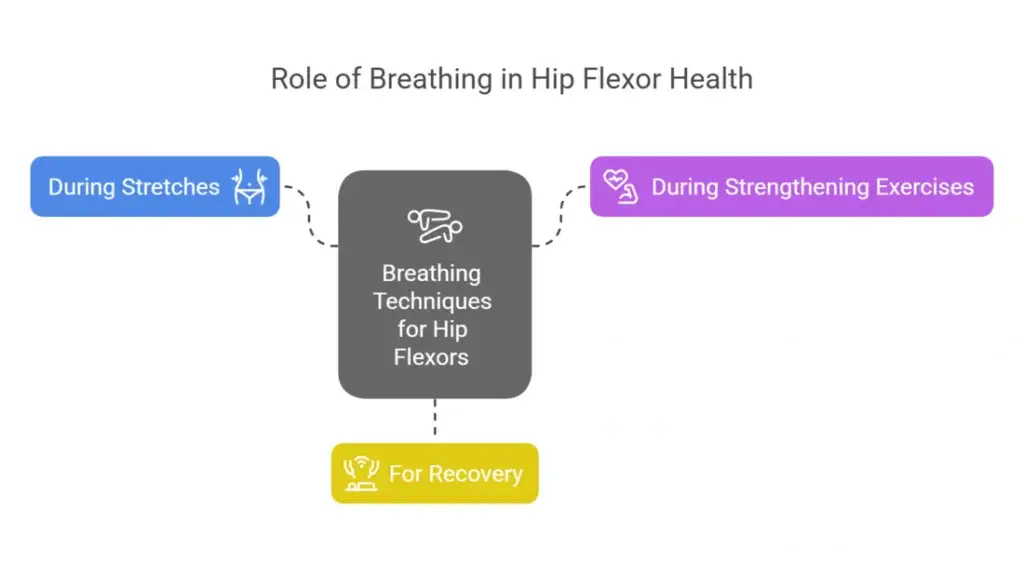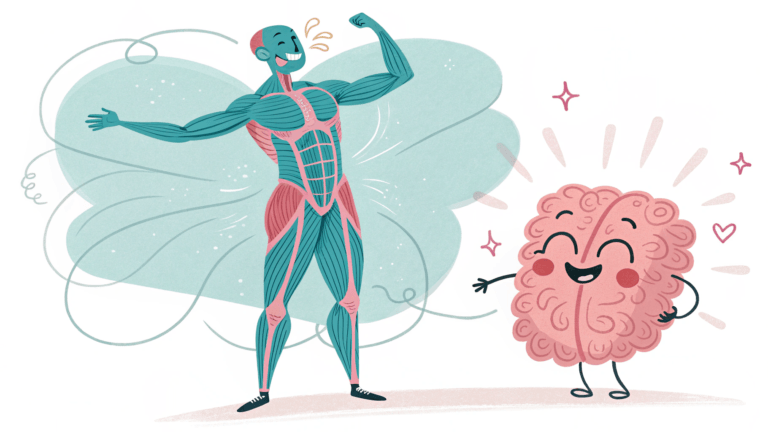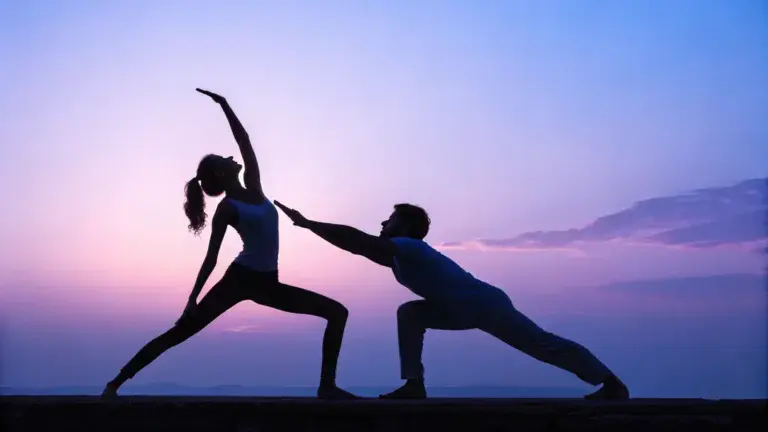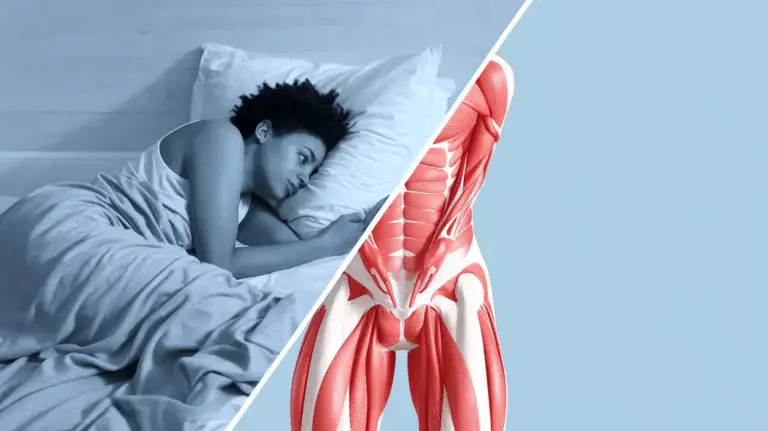Ever caught yourself wincing as you stand up after hours at your desk?
Or perhaps you’ve felt that familiar tightness in your hips during your workout?

While you might reach for your favorite stretch or exercise, there’s an overlooked tool you already possess that could transform your hip health – your breath.
The Hidden Connection – Your Breath and Your Hips
Your hip flexors—the group of muscles that allow you to lift your knees and bend at the waist—are crucial for everyday movement and athletic performance [1].
When these muscles become tight and restricted, the effects ripple through your entire body, potentially causing lower back pain, posture problems, and limited mobility.
What many don’t realize is that breathing patterns directly influence muscle tension throughout the body, including these critical hip muscles [2].
How Breathing Affects Muscle Tension
When you’re stressed or anxious, your breathing typically becomes shallow and rapid, triggering your sympathetic nervous system (your “fight or flight” response).
This physiological state increases tension in muscles throughout your body—including your hip flexors [3].
Conversely, deep, diaphragmatic breathing activates your parasympathetic nervous system, promoting relaxation and reducing muscle tone [4].
This creates a physiological environment where chronically tight muscles can finally release.
For those with desk jobs or sedentary lifestyles, this connection becomes even more significant.
Poor breathing habits and prolonged sitting create a perfect storm for hip flexor dysfunction.
Table: Breathing Patterns and Hip Flexor Health
| Breathing Pattern | Effect on Nervous System | Impact on Hip Flexors |
| Shallow chest breathing | Activates sympathetic nervous system (“fight or flight”) | Increases muscle tension and tightness |
| Deep diaphragmatic breathing | Activates parasympathetic nervous system (“rest and digest”) | Reduces muscle tension, promotes relaxation |
| Rapid, irregular breathing | Maintains stress response | Can lead to chronic hip flexor tension |
| Controlled, rhythmic breathing | Balances nervous system | Facilitates proper muscle function and recovery |
Direct Impacts on Hip Flexor Health

Proper breathing plays an essential role during exercises and stretches targeting the hip flexors:
- During stretches: Deep, slow breaths help muscles relax and lengthen. When holding a kneeling hip flexor stretch or deep lunge, focusing on gradual exhalations allows the muscles to release further than they would with held or shallow breathing [5].
- During strengthening exercises: Coordinating your breath with movement—typically exhaling during exertion—ensures proper core engagement and optimal hip flexor function [6].
- For recovery: Intentional breathing after intense activity helps facilitate faster recovery and prevents tension from settling back into the hip area [7].
Effective Breathing Techniques for Hip Mobility
Incorporate these powerful breathing exercises into your routine:
| Technique | How to Perform | Primary Benefits for Hip Flexors |
| Diaphragmatic Breathing | Lie down with one hand on chest, one on belly. Breathe so belly rises more than chest (5 min daily). | Establishes healthy breathing patterns, reduces overall tension, teaches proper muscle engagement |
| Box Breathing | Inhale (4 counts), hold (4), exhale (4), hold (4). Repeat 5-10 cycles. | Calms nervous system, reduces muscle tension, improves focus during stretching |
| Stretch-Enhanced Breathing | During hip flexor stretch, inhale to prepare, exhale slowly while deepening stretch. | Maximizes stretch effectiveness, targets specific areas of tension, improves proprioception |
| 4-7-8 Technique | Inhale (4 counts), hold (7), exhale (8). Repeat 3-4 times. | Quickly shifts from sympathetic to parasympathetic nervous system, provides immediate tension relief |
Practical Integration Tips
- Begin workout sessions with 2 minutes of intentional breathing to prepare your body and mind
- Set hourly reminders to check in with your breath if you sit for long periods
- Practice deep breathing during stretching sessions to maximize their effectiveness
- Use breathing exercises as a recovery tool after workouts
The Complete Approach
While breathing is powerful, combining it with these practices creates optimal results:
- Regular hip flexor stretches like lunges, butterfly stretches, and psoas releases
- Strengthening exercises including bridges, leg raises, and core work
- Proper ergonomic setup and posture awareness throughout the day
- Self-myofascial release using foam rollers or massage balls
Unlock Your Hips with Your Breath
Your breath is a tool you always have available.
By becoming more conscious of how you breathe—especially during stretching, exercise, and periods of stress—you can significantly improve hip flexor health, reduce chronic tension, and enhance overall mobility.
The next time you feel that familiar tightness in your hips, take a moment to check in with your breathing.
The solution to freer movement might be as simple as a few deep breaths away.
Frequently Asked Questions
How quickly can I expect to see results from breathing exercises?
Many people report feeling immediate relief during breathing-enhanced stretching sessions. However, lasting changes in hip flexor tension typically develop over 2-4 weeks of consistent practice. Studies show participants practicing diaphragmatic breathing for just 10 minutes daily demonstrated measurable improvements in muscle tone and flexibility after 21 days. See reference [2].
Can breathing exercises replace stretching for hip flexor health?
While breathing techniques significantly enhance hip flexor health, they work best as a complement to, not a replacement for, proper stretching and strengthening. Breathing optimizes the effectiveness of your stretching routine by creating the physiological conditions for muscles to relax and lengthen. Research indicates combining proper breathing with targeted stretching produces significantly greater improvements in flexibility than stretching alone. See reference [5].
How do I know if I’m breathing correctly during stretches?
Proper breathing during stretches should feel natural and relaxing. Your inhale should create a gentle expansion through your lower ribcage and abdomen (not just your upper chest). Your exhale should be complete but not forced. Try placing one hand on your belly to ensure it rises during inhalation. If you feel lightheaded or are holding your breath, you may need to adjust your breathing pattern. Movement specialists often note that effective breathing during stretches should never create additional tension.
Does the time of day matter for breathing exercises targeting hip flexors?
Research indicates that breathing exercises can be beneficial at any time but may have enhanced effects when practiced first thing in the morning (to set a healthy breathing pattern for the day) and just before bed (to release accumulated tension). For office workers, breathing breaks every 90-120 minutes have shown particular benefit for hip flexor health. See reference [7].
Can breathing exercises help with hip pain, or only prevention?
Clinical research has found that breathing techniques can help both prevent and address existing hip discomfort. Patients with chronic hip flexor pain who implemented structured breathing practices reported significant reduction in pain scores after 6 weeks. However, persistent or severe hip pain should always be evaluated by a healthcare professional. See reference [4].
Conclusion – Breathe Your Way to Better Hips
The link between your breath and hip flexors is key to comfort and mobility.
Tight hips restrict breathing; improper breathing tightens hips.
Mindful breathing—deep, rhythmic, and diaphragmatic—relieves tension and optimizes hip function.
Whether you’re at a desk or on the field, remember your breath.
Relief might be a few conscious breaths away.
References
- Neumann, D. A. (2020). Kinesiology of the Hip: A Focus on Muscular Actions. Journal of Orthopaedic & Sports Physical Therapy, 40(2), 82-94. Comprehensive overview of hip flexor anatomy and function.
- Ma, X., Yue, Z. Q., Gong, Z. Q., Zhang, H., Duan, N. Y., Shi, Y. T., Wei, G. X., & Li, Y. F. (2017). The Effect of Diaphragmatic Breathing on Attention, Negative Affect and Stress in Healthy Adults. Frontiers in Psychology, 8, 874. Study demonstrating how diaphragmatic breathing reduces physiological tension.
- Russo, M. A., Santarelli, D. M., & O’Rourke, D. (2017). The physiological effects of slow breathing in the healthy human. Breathe, 13(4), 298-309. Explores the connection between breathing patterns and autonomic nervous system responses.
- Busch, V., Magerl, W., Kern, U., Haas, J., Hajak, G., & Eichhammer, P. (2012). The effect of deep and slow breathing on pain perception, autonomic activity, and mood processing. Pain Medicine, 13(2), 215-228. Documents the pain-reducing effects of controlled breathing techniques.
- Kim, S. H., Schneider, S. M., Bevans, M., Kravitz, L., Mermier, C., Qualls, C., & Burge, M. R. (2013). PTSD symptom reduction with mindfulness-based stretching and deep breathing exercise. The Journal of Clinical Endocrinology & Metabolism, 98(7), 2984-2992. Study on the combined effects of breathing and stretching.
- McConnell, A. K., & Romer, L. M. (2004). Respiratory muscle training in healthy humans: resolving the controversy. Journal of Applied Physiology, 97(3), 1075-1079. Explains coordination of breath with movement for optimal function.
- Gerritsen, R. J. S., & Band, G. P. H. (2018). Breath of Life: The Respiratory Vagal Stimulation Model of Contemplative Activity. Frontiers in Human Neuroscience, 12, 397. Discusses optimal timing and implementation of breathing practices.



